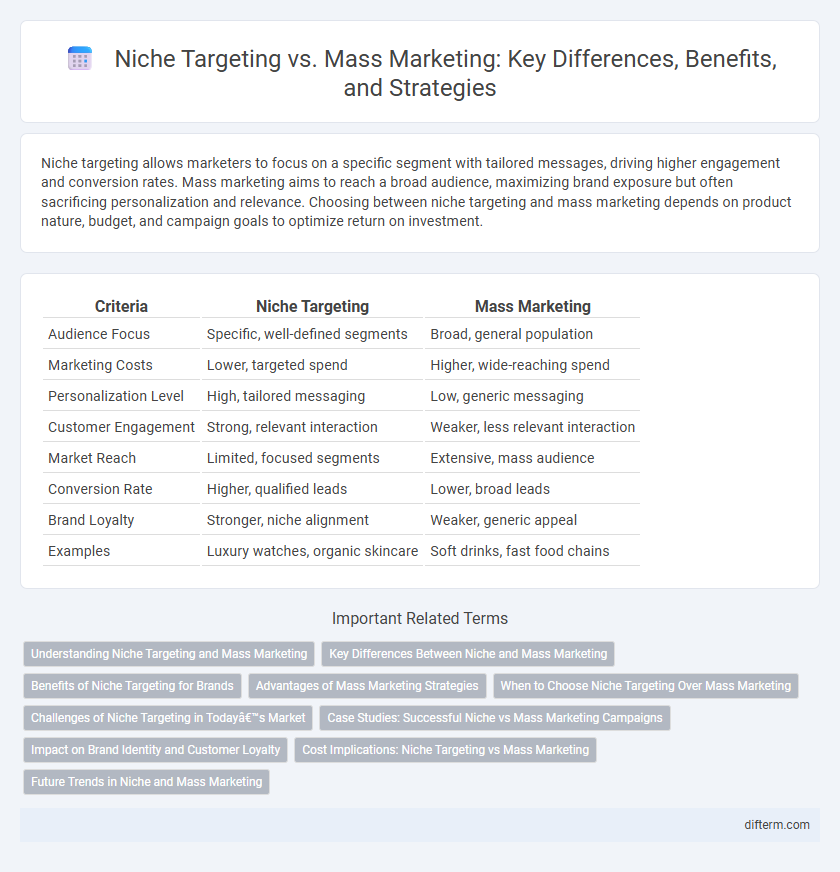Niche targeting allows marketers to focus on a specific segment with tailored messages, driving higher engagement and conversion rates. Mass marketing aims to reach a broad audience, maximizing brand exposure but often sacrificing personalization and relevance. Choosing between niche targeting and mass marketing depends on product nature, budget, and campaign goals to optimize return on investment.
Table of Comparison
| Criteria | Niche Targeting | Mass Marketing |
|---|---|---|
| Audience Focus | Specific, well-defined segments | Broad, general population |
| Marketing Costs | Lower, targeted spend | Higher, wide-reaching spend |
| Personalization Level | High, tailored messaging | Low, generic messaging |
| Customer Engagement | Strong, relevant interaction | Weaker, less relevant interaction |
| Market Reach | Limited, focused segments | Extensive, mass audience |
| Conversion Rate | Higher, qualified leads | Lower, broad leads |
| Brand Loyalty | Stronger, niche alignment | Weaker, generic appeal |
| Examples | Luxury watches, organic skincare | Soft drinks, fast food chains |
Understanding Niche Targeting and Mass Marketing
Niche targeting focuses on identifying and serving a specific segment of the market with tailored marketing strategies, which increases relevance and engagement. Mass marketing aims to reach the broadest audience possible by promoting a product or service using generalized messaging to maximize exposure. Understanding the key differences between these approaches enables marketers to optimize resource allocation and improve campaign effectiveness based on product suitability and target consumer behavior.
Key Differences Between Niche and Mass Marketing
Niche targeting concentrates on a specific, well-defined segment of the market, aiming to meet the unique needs and preferences of a smaller audience, which often leads to higher customer loyalty and engagement. In contrast, mass marketing targets a broad, general audience with a universal message designed to reach as many potential customers as possible, prioritizing volume and brand recognition. The key differences lie in targeting precision, marketing messaging customization, and resource allocation, with niche marketing requiring detailed market research and tailored campaigns, whereas mass marketing relies on widespread appeal and economies of scale.
Benefits of Niche Targeting for Brands
Niche targeting allows brands to focus on a specific audience with tailored messaging, resulting in higher engagement and customer loyalty. It enables efficient allocation of marketing resources by minimizing waste and maximizing ROI through personalized campaigns. Brands also benefit from reduced competition and the ability to establish strong authority within a specialized market segment.
Advantages of Mass Marketing Strategies
Mass marketing strategies maximize brand exposure by targeting a broad audience, leading to economies of scale in advertising and production. This approach enhances brand recognition and drives higher sales volume across diverse consumer segments. Companies utilizing mass marketing can capitalize on widespread market demand and achieve cost efficiency.
When to Choose Niche Targeting Over Mass Marketing
Niche targeting should be chosen over mass marketing when a business aims to address specific customer needs with tailored products or services, maximizing customer loyalty and higher conversion rates. It is ideal for companies with limited resources looking to penetrate specialized markets where competition is less intense and customer engagement can be more personalized. Businesses operating in industries like luxury goods, health supplements, or specialized software often benefit from niche marketing strategies to enhance market relevance and profitability.
Challenges of Niche Targeting in Today’s Market
Niche targeting faces challenges such as limited audience size, which can restrict revenue potential and increase customer acquisition costs in today's competitive market. Brands must invest heavily in precise data analytics and personalized content to effectively engage and retain a smaller, specific customer base. Rapid market shifts and changing consumer preferences also demand agility, making sustained niche targeting resource-intensive and complex.
Case Studies: Successful Niche vs Mass Marketing Campaigns
Successful niche marketing campaigns, such as Tesla's focus on environmentally conscious early adopters, demonstrate the power of targeting specific segments with tailored messages. In contrast, Coca-Cola's mass marketing approach leverages broad appeal through global brand consistency and high-frequency advertising, achieving widespread consumer reach. Case studies reveal niche strategies often yield higher engagement and loyalty, while mass marketing drives scale and brand awareness.
Impact on Brand Identity and Customer Loyalty
Niche targeting strengthens brand identity by catering to specific customer needs, creating a unique market position that enhances customer loyalty through personalized experiences. Mass marketing promotes widespread brand recognition but risks diluting brand identity by appealing to a broad audience with generalized messaging. Brands leveraging niche targeting often see higher customer retention rates due to deeper emotional connections and tailored value propositions.
Cost Implications: Niche Targeting vs Mass Marketing
Niche targeting typically involves lower overall marketing costs due to its focused approach on a specific audience, reducing wasted ad spend and increasing return on investment. Mass marketing demands higher budgets for broad-reaching campaigns across multiple channels to capture a diverse consumer base, often resulting in higher media and production expenses. Businesses must weigh the cost-effectiveness of precise audience engagement against the expansive reach of mass marketing when planning their budgets.
Future Trends in Niche and Mass Marketing
Niche targeting leverages advanced data analytics and AI to deliver highly personalized content, significantly enhancing customer engagement and conversion rates. Mass marketing is evolving through automation and real-time data integration, enabling broader reach while maintaining some level of customization. Future trends indicate a hybrid approach where brands combine niche precision with scalable mass strategies to optimize ROI and customer loyalty.
Niche Targeting vs Mass Marketing Infographic

 difterm.com
difterm.com